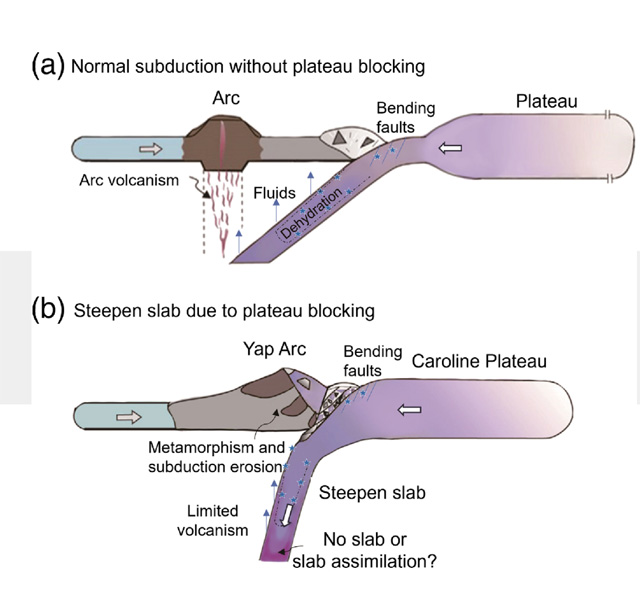29 August 2024–About 21 million years ago the Yap Trench collided with a thick piece of ocean crust called the Caroline Plateau. But is the Yap Trench still an active subduction zone? And why does the Yap Trench look a little different from its subduction zone neighbors in the western Pacific Ocean?
Data gleaned from ocean bottom seismometers (OBS) can help answer some of these questions, according to a new paper in Seismological Research Letters.
Gaohua Zhu of the Chinese Academy of Sciences and colleagues used these data to identify a steep, nearly vertically angled subducting slab at the trench. Their analysis suggests the Caroline Plateau may have blocked slab subduction near the trench, causing the front of the slab to bend and sink.
However, the pattern of seismicity recorded by the OBS indicates that subduction is still happening at the trench, the researchers write.
“The results provide a clear earthquake distribution pattern and evidence for slow but active subduction,” said Zhu. “I think the buoyant Caroline Oceanic plateau can slow but not completely block the subduction activity.”
The Yap Trench is a rare example of an oceanic plateau subduction system, so Zhu and colleagues hope their findings will help scientists better understand the range of tectonic interactions and seismic hazard posed by these systems.
The researchers used data collected by a OBS array experiment in the Yap region from April 2016 to May 2017, deployed by the research vessel Kexue from the Institute of Oceanology, Chinese Academy of Sciences. The data were used to build a local earthquake catalog containing 2,138 earthquakes, 712 of which the researchers were able to precisely locate.

“OBS were necessary for seismological studies at the Yap subduction zone, since the Yap region is almost entirely covered by seawater and there are no close seismic permanent stations,” Zhu explained.
The Yap Trench is part of a continuous line of arcuate trenches in the western Pacific subduction zone, and at first glance it seems similar to these trenches. The Yap system contains the characteristic subduction zone features such as a deep trench with an island arc and back-arc basin on the overriding plate.
But the distance between the Yap trench and the volcanic arc is about one-third of the distance of this feature in other western Pacific subduction zones, and there are no active arc volcanoes along the Yap system.
Zhu and colleagues suggest the steeply bent subducted slab may help explain these differences. After locating several earthquakes with depths larger than 50 kilometers, the researchers conclude that the slab reaches about 80 kilometers in depth at a near-vertical dip, perhaps creating an unusually shortened region between the subducting and overlying plates.
Yap’s much slower subduction rate—estimated to be less than 6 millimeters per year, compared to about 30-60 millimeters per year in the Mariana Trench—combined with the steep slab could also explain the lack of volcanism, Zhu said.
“First, a steep slab may result in an unusual thermal structure in the region. Second, the slow subduction helps to heat the slab sufficiently, and therefore the slab may be dehydrated at shallow depth due to increased temperature,” she said. “If the slab releases water at very shallow depths, it may play limited roles in promoting mantle melting or magma generation.”
The researchers are collecting a variety of data from the region, including heat flow and gravity measures, to produce a thermal model and structure of the Yap subduction zone that will help them better understand its earthquakes and arc volcanism.
